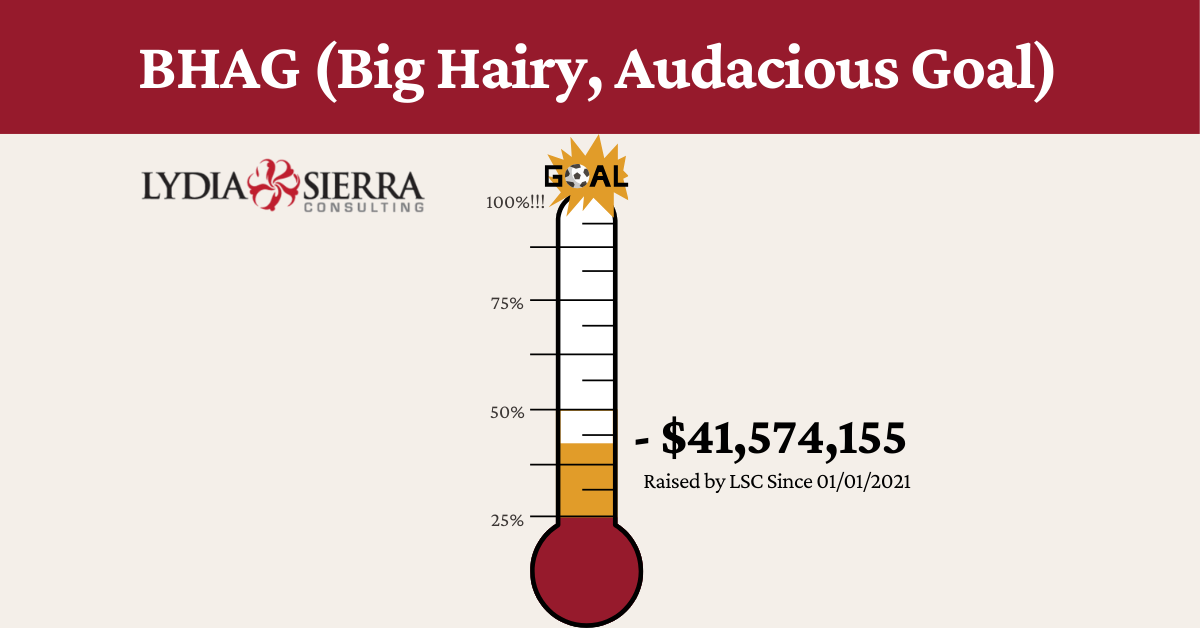In the nonprofit world, success is rarely the result of a single person’s effort. It’s the product of many people—staff, board members, volunteers, funders, and partners—working together toward a shared mission.
At Lydia Sierra Consulting (LSC), we’ve seen this truth play out again and again: when teams collaborate well internally, they raise more money, run stronger programs, and ultimately make a bigger impact. That’s why our 2024 Impact Report, to be released in September 2025, is built around the theme “It Takes a Team.”
Today, I want to share a few lessons from that report, along with client stories—and even one from my own entrepreneurial journey—that show how the right mix of collaboration and strategy can transform a nonprofit’s capacity (and a small business!).
Lesson #1: Clarity Creates Collaboration
One of the biggest barriers to effective teamwork is confusion—about roles, goals, or priorities. When everyone is clear on what needs to be done and who is responsible, it’s easier to align efforts and move projects forward.
In challenging times—what I call The Lean Years—tough decisions are unavoidable. Sometimes that means closing programs that lack dedicated funding and are pulling resources from other, more sustainable initiatives.
When I began my consulting career in 2005, I handled everything: incorporating nonprofits, securing 501(c)(3) status, building boards, designing programs, and writing proposals. I even founded and led a volunteer-run nonprofit of my own. While that experience was invaluable, it left me physically burned out and financially strained.
By 2016, I knew something had to change. I clarified LSC’s focus to prospect research and proposal development, built online systems for remote work, and began growing a small portfolio of clients and a dedicated team. When COVID-19 hit, we were ready—and able—to help dozens of nonprofits secure critical relief funding. We scaled from a team of four to ten, serving over a dozen clients.
That clarity in our offerings made all the difference. My team knew exactly what to focus on each day and could prioritize with confidence. And yes, I’ve had to take my own advice—closing underfunded service offerings and making difficult staffing decisions when needed.
The result? To date, we’ve raised over $40 million for underserved communities—because everyone was rowing in the same direction.
Lesson #2: Fundraising Is a Whole-Organization Effort
Many nonprofits treat fundraising as the sole responsibility of the development department. In reality, sustainable fundraising requires engagement from every corner of the organization.
Program staff provide compelling impact data. Board members open doors to new relationships. Leadership sets the tone for a culture of philanthropy.
One of our Bronx-based partners recently embraced this mindset shift. When their program team began sharing stories and photos from the field, their proposals became richer and more persuasive. That storytelling synergy helped them secure a six-figure government grant they had previously been passed over for.
Lesson #3: Outside Partners Can Strengthen the Inside
Sometimes, the best way to strengthen internal collaboration is to bring in outside expertise. That’s where LSC often comes in—not to replace staff, but to act as an extension of the team.
We’ve partnered with organizations to conduct prospect research, manage proposal timelines, and ensure applications align with funder priorities—freeing internal teams to focus on delivering programs.
One Detroit-based organization told us, “It feels like you’re not just our consultants, but part of our family.” That’s exactly the kind of partnership we strive for.
Practical Ways to Build Collaborative Capacity in Your Nonprofit
If you’re ready to strengthen internal collaboration, here are three practical actions you can start this month:
- Create a shared annual program, operations, and funding plan so everyone knows what’s ahead. Secure buy-in from all team members, address concerns, and keep the focus on shared goals.
- Schedule monthly cross-department check-ins to share updates, celebrate successes, and identify challenges early. Housekeeping tip: clarify roles and expectations.
- Invest in systems and tools—shared drives, CRM software, project trackers—and document standard operating procedures (SOPs) for key roles. This preserves institutional knowledge and smooths transitions during staff changes.
Why This Matters Now
As we enter the final stretch of the year, the nonprofits that will see the biggest wins—whether in fundraising or program impact—are those whose teams are working in sync.
If your team is stretched thin, siloed, or struggling to coordinate, now is the time to address it. Strong collaboration isn’t just a “nice to have”—it’s the foundation for sustainable growth.
At LSC, we believe every nonprofit deserves a partner who will roll up their sleeves, align with your mission, and help you achieve big wins without burning out your team.
If you’re ready to strengthen collaboration and take your fundraising to the next level, let’s talk. Together, we can make your team unstoppable.
Schedule a 30-minute Discovery Call to learn more about our tailored services.
Subscribe to receive monthly fund development advice in your inbox!







